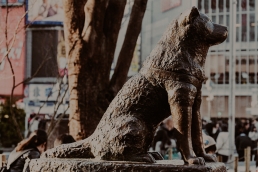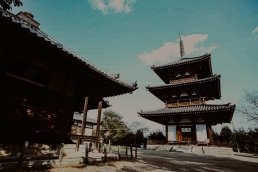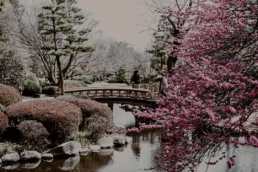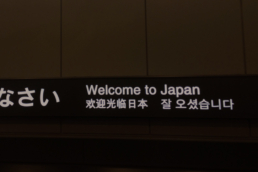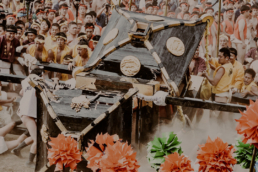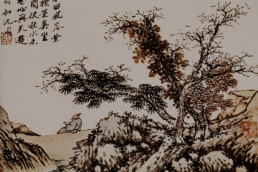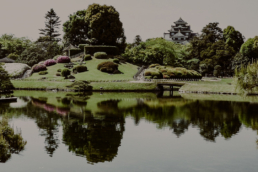Ten things you don't know about Hachiko
Everyone, but really everyone, knows the story of the faithful Hachiko, the dog that in the 30's moved the hearts of the whole world for his deep fidelity, but not everyone knows some details about this sweet dog whose symbolic statue stands in Shibuya.
10 things you don't know about Hachiko
Author: Sara

photo credits: lastampa.it
1- The Origins
The beautiful Akita-inu was born in 1923 in Odate in Akita Prefecture (hence the breed name, "Akita dog") and was purchased by the scientist Hidesaburo Ueno who named him Hachi, "8". Right in Odate, in front of the station, there is another statue of Hachi a shrine and the Akitainu Hozonkai Museum.

photo credits: keblog.it
2- Love overcomes evil
.
When Ueno died in 1925, Hachi found a new home with the scientist's former gardener, Kikuzaburo Kobayashi in Tomigaya, not far from Shibuya. Every day the faithful dog went to Shibuya station to wait for the return of Ueno, but for 10 years this "walk" was not always quiet: Hachiko was mistreated and beaten several times by pedestrians, children and people without any humanity. Shameful, isn't it?

photo credits: greenme.it
3- Hachi becomes Hachiko
.
In 1932, the president of the Nihon Ken Hozonkai, an association for the preservation of Japanese dogs, Hirokichi Saito, learned of Hachi's history and wrote an article recounting the vicissitudes and mistreatment suffered by this faithful dog, transforming it in a short time into a symbol. It was at this point that the suffix "ko" was added to Hachi's name to show respect for his devotion and loyalty.
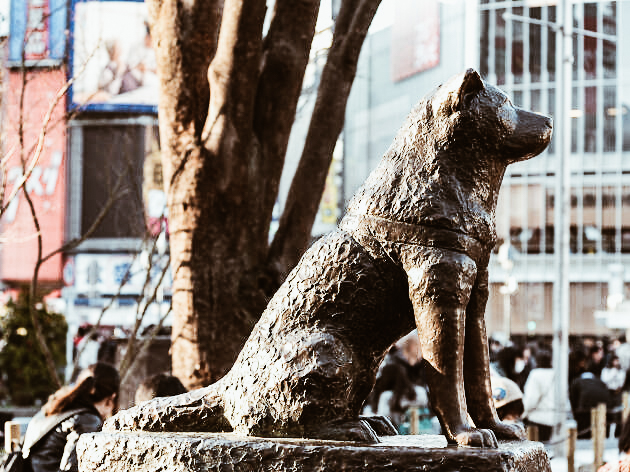
photo credits: hotcorn.com
4- The Honorary Statue
Teru Ando, Saito's acquaintance, sculpted the famous Hachiko statue (while the dog was still alive!) which was unveiled in 1934. Before this happened several swindlers tried to get money out of him claiming to be the creators of the statue! There is really no limit to human greed...

photo credits: japantravel.com
5- The Merger of the Statues
.
World War II spared nothing, not even the Hachiko statues. The metal with which they were made had to be used "for the good of the war" and so they were melted down.
At the end of the Pacific War Ando's son, Takeshi, built the current statue in Shibuya. The one at Odate Station was also rebuilt in 1967.
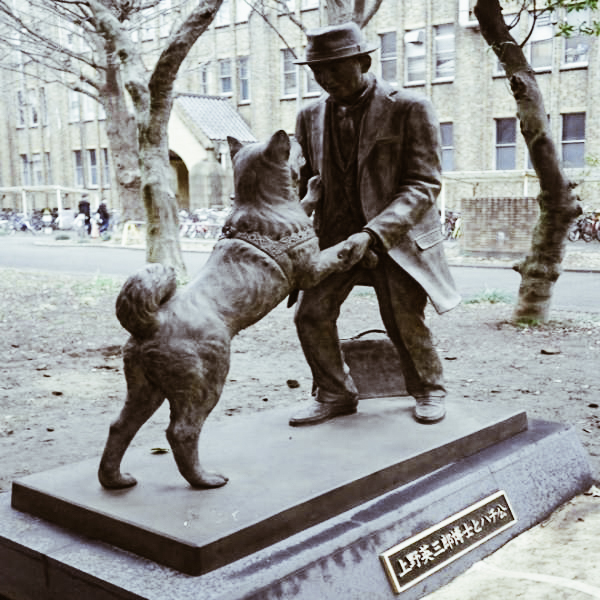
photo credits: animalpedia.it
6- Hachiko and Ueno forever together
.
So far we have always talked about the statues dedicated to the puppy, but there is another, beautiful one that brings together Hachiko and his master. It was built 80 years after Hachiko's death, when the University of Tokyo decided to pay tribute to the two protagonists of the sad story. Thanks to donations from individuals and companies, over 10 million yen made the reunion between the dog and his master possible. Today the statue stands on the campus of the University of Tokyo, right next to Ueno Park.
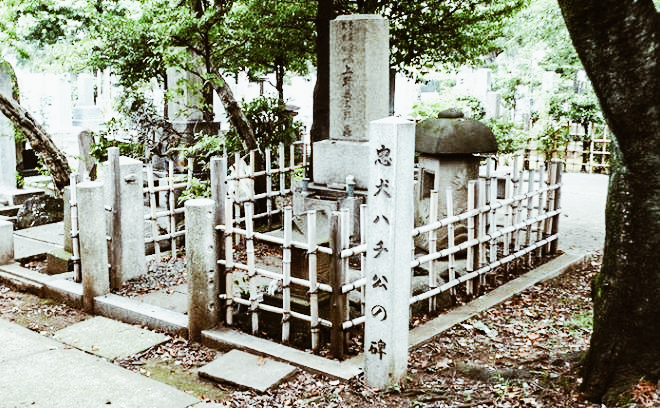
photo credits: womanuntamed.com
7- A Cemetery Full of Charm
I guess I'm one of the few people who like to visit cemeteries, and the Aoyama Cemetery, dating back to 1872, is definitely one of the most beautiful: near the Gaienmae and Aoyama Itchome stations, it stretches out like a huge park and is home to many famous people whose tombstones rise up to reveal a unique architecture. Of course Ueno lies right here and next to his grave there is a monument erected immediately after the death of Hachiko in 1935.

photo credits: wikimedia.org
8- Between the macabre and science
.
I would almost call this point disgusting, but if you have the courage (and the stomach) of iron then know that it is possible to observe the internal organs of Hachiko preserved in sample bottles at the museum of the archives of the Faculty of Agriculture of the University of Tokyo, near Ueno Park. Various autopsies performed between 1935 and 2010 had found infestations of parasitic diseases and, finally, cancer, the real cause of Hachi's death. At the National Museum of Nature and Science there is also a taxidermied Hachiko with the original fur of the dog......

photo credits: timeout.com
9- The Protectors of Tokyo
The statue of samurai Saigo Takamori with his faithful Tsun also stands in Ueno Park. Tsun and Hachiko quickly became a symbol for the Japanese and declared the "protectors of Tokyo and the Japanese economy."

photo credits: ilgiornale.it
10- Richard Gere as Ueno?
.
I'm sure everyone (or almost everyone) has seen the movie "Hachiko - Your Best Friend" (Original title: "Hachi: A Dog's Tale") , but have you stopped to think that this 2009 film is set in the United States? The story is nonetheless heartbreaking and beautiful, but it fails to bring Japanese culture to light in the way that the original 1987 film, "Hachiko Monogatari" does.
Nara, the capital of Buddhism in Japan
Japan, like Italy, has many tourist destinations and among them are the seven temples of Nara, a destination rich in history and culture.
The 7 Temples of Nara, the capital of Buddhism
Autore: Sara

Those who approach the culture of the Rising Sun for the first time are led to believe that Buddhism has always been a strictly Japanese philosophy, also thanks to the numerous temples scattered throughout the country. In reality, few people know that it was a Korean king who "exported" this religion to Japan! It all began when the prefecture of Nara was the center of politics, culture and economy of the country. The Japanese people were purely Shintoist, that is a follower of "Shinto" (神道): a polytheistic religion of animist type that revolves around the existence of many Kami ("gods", "spirits") that are believed to inhabit all things. In 552, King Seond of Baekje, a kingdom in the southwest of the Korean peninsula, brought to the Japanese court a statue of Shakyamuni (historical Buddha) and many satras. The emperor of the time, Kimmei, was attracted and slowly Buddhism established itself as the new state religion.
Nara thus became Nanto Shichi Daiji (南都七大寺), the capital of Buddhist temples built by imperial order, now a world heritage site, and includes:
- Horyuji(法隆寺)
- Houkiji (法起寺)
- Todaiji(東大寺)
- Kofukuji(興福寺)
- Gangoji (元興寺)
- Yakushiji (薬師寺)
- Toshodaiji (唐招提寺)
The Seven Temples of Nara
.
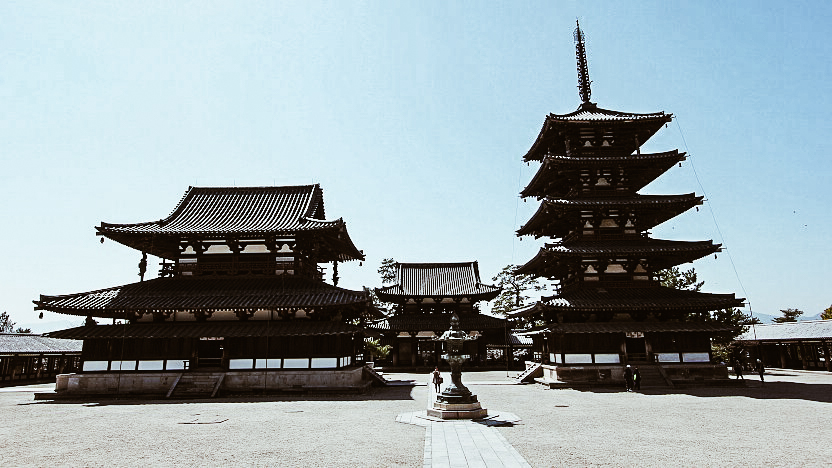
photo credits: https://www.japan-guide.com
Horyuji
Horyuji Temple is the first site to be designated a UNESCO World Heritage Site in Japan. Founded in 607 by Prince Shotoku at the behest of his father, Emperor Yomei, it was rebuilt in 670 following a fire that almost burned it down, and today is considered the cradle of Japanese Buddhism. The area over which the large temple complex stretches can be divided into the west side, Saiin garan (西院伽藍, where the five-story pagoda, golden hall, corridor and internal portal are located) and the east side, Toin garan (東院伽藍, where the octagonal Yumedono (夢殿, the hall of visions) stands.
Official Site: http://www.horyuji.or.jp/assets/images/pdf/english.pdf
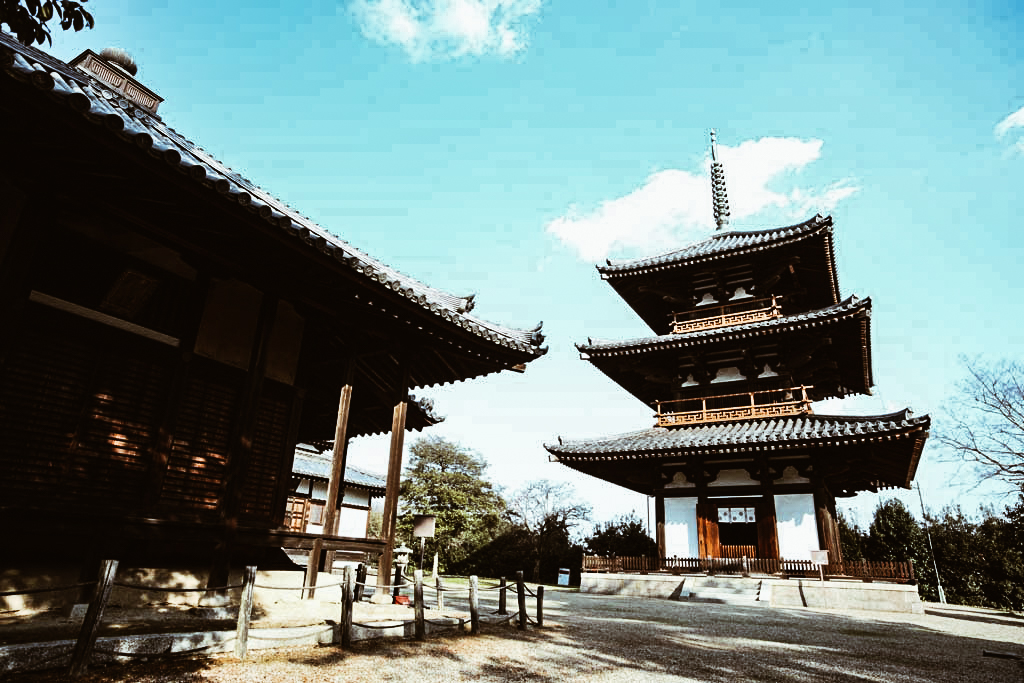
photo credits: masterpiece-of-japanese-culture.com
Houkiji
This temple with multiple identities (it is in fact also known as Okamoto-dera 岡本寺, Okamotoniji 岡本尼寺, Ikejiri-dera 池後寺 and Ikejiriniji 池後尼寺) is located just under 2 km from Horyuji. It was originally the palace of Shotoku Taishi's family, but before his death he ordered his son Yamashirono-ooenoo to rebuild it in the form of a temple. Houkiji consists of a main hall and a 3-story pagoda, about 23 meters high: the largest and oldest of its kind in Japan (it was built in 685). A symbol of this temple is undoubtedly the 11-headed wooden Kannon and the bronze Bosatsu (both gods of compassion).
Official Site: http://www.horyuji.or.jp/assets/images/pdf/english.pdf

photo credits: shoreexcursions.asia
Todaiji
Todaiji was founded by Emperor Shomu in 752, with the sole purpose of housing the statue of the Great Buddha in the Great Hall (Daibutsuden). After 7 long years of construction, the temple was burned down as a result of war in 1180 and continued to suffer the consequences of conflict until 1567. Restored each time, the temple's current form dates back to 1709 and its seated Buddha represents Vairocana and is flanked by two Bodhisattvas. The temple's grounds extend across almost the entire northern part of Nara National Park, so it is not uncommon to come across the famous deer seeking attention!
Official Site: http://www.todaiji.or.jp/english/index.html
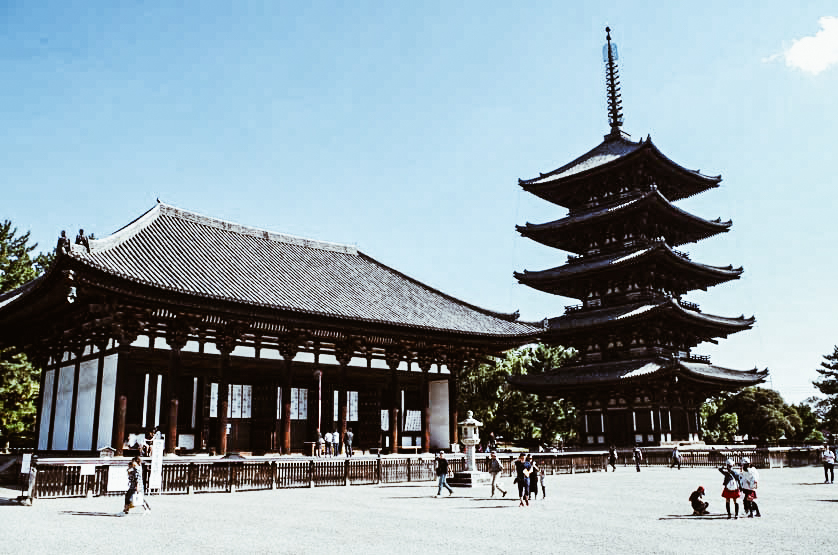
photo credits: japanvisitor.com
Kofukuji
Kofukuji was originally the temple of the powerful Fujiwara clan and one of the main temples of the Hosso (法相宗) sect, one of the six sects of Nanto. The temple consists of several buildings of important historical value and as many as two pagodas: one five-story and one three-story, which unfortunately cannot be visited. To make up for this lack, however, there is the National Treasure Museum where you can admire the statue of Ashura and the bronze head of Buddha.
Official Site: https://www.kohfukuji.com/english.html
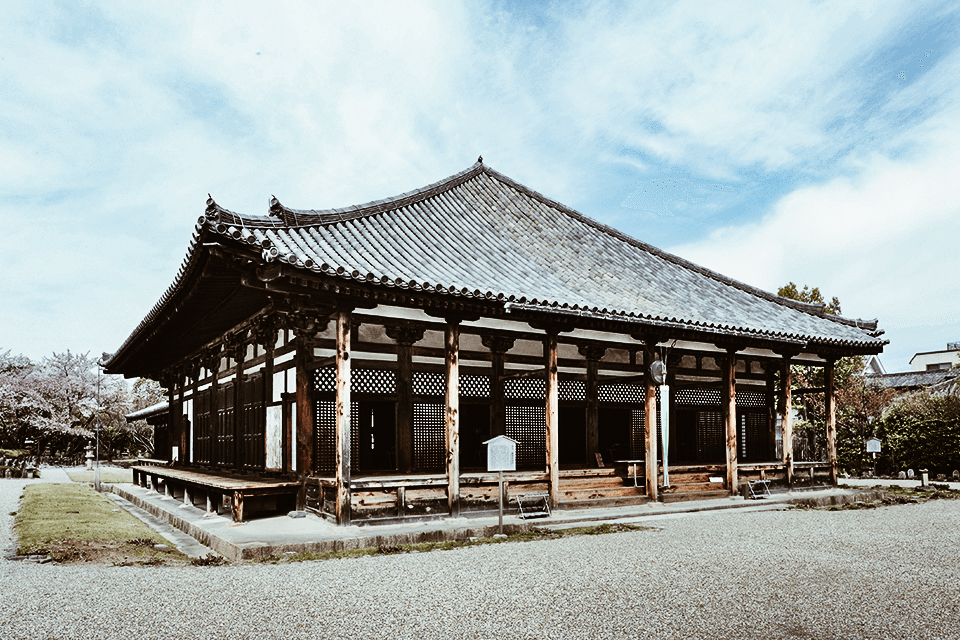
photo credits: kintetsu.co.jp
Gangoji
Founded by Soga no Umako, Gangoji is among the oldest temples in Japan, having been moved from Asuka to Nara in 718. Almost as a gloomy tradition, this temple also suffered the wrath of nature and the devastation of fire and in 1451 almost the entire structure was destroyed and it was no longer possible to recover the ancient splendor of Gangoji except for the Zenshitsu Hall, located at the back, the only original survivor.
Official Site: https://gangoji-tera.or.jp/

photo credits: japan-guide.com/
Yakushiji
Esattamente come Kofukuji, anche Yakushiji è il tempio principale della setta Hosso del buddismo. Fu costruito dall’imperatore Tenmu per sua moglie nel 680. Come ogni tempio, anche questa volta troviamo una grande statua del Buddha: in questo caso Yakushi-Nyorai possiede il potere della guarigione ed è in grado di dare conforto. Inoltre Yakushiji possiede due pagode, una sala dorata ed una collezione di oggetti d'arte buddista, tra cui una Triade Yakushi, un Kannon-Sho e dipinti di grande pregio
Sito Ufficiale: http://www.nara-yakushiji.com/
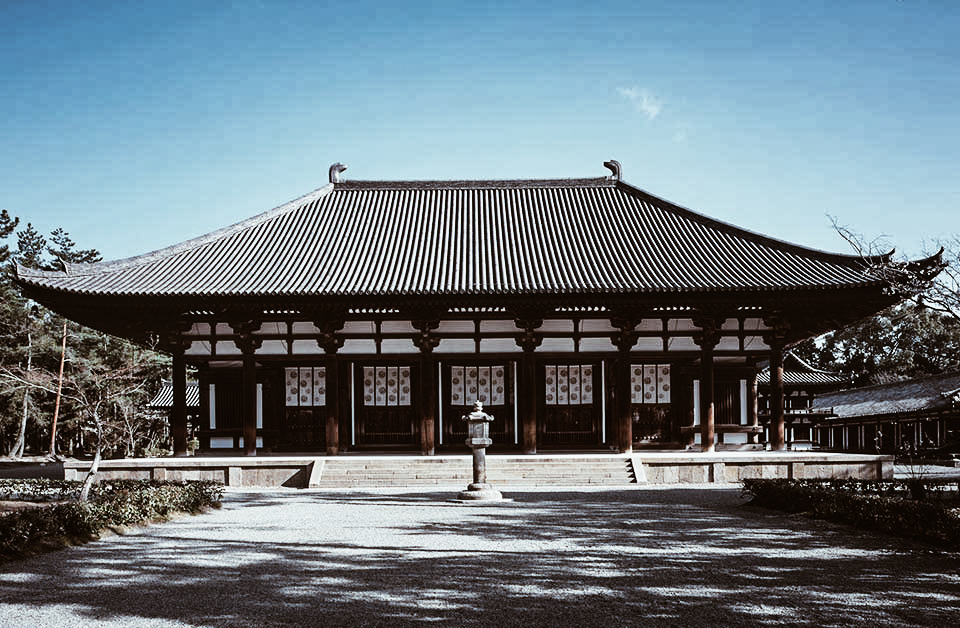
photo credits: toshodaiji.jp/
Toshodaiji
Toshodaiji was the first temple founded in 759 by a Chinese priest, Ganjin, who was sent by the emperor for the purpose of teaching priests and improving Buddhism in Japan. His teachings had a great influence for the country and today it is the main temple of the Rishu (律宗) sect. The main hall, Kondo, contains 9 statues of Buddha!
Official website: https://www.toshodaiji.jp/english/index.html
7 Temples, 7 fascinating wonders dedicated to the care of the soul: although they may seem extremely similar to each other, each building is characterized by unique and precious elements to discover and admire! How about dedicating some of your time to walk around Nara to discover these devout places? Have you already been there? Let us know your impressions and emotions!
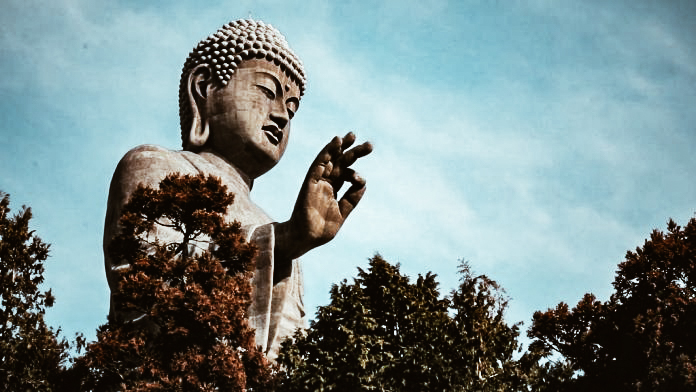
photo credits: thejapanesedreams.com
The wonderful gardens of Japan
With Japan Italy Bridge we have already addressed a deep focus on the Imperial Palace and its gardens, but those are not the only gardens of Japan. Today we will talk about the most beautiful green spaces of the Rising Sun.
Gardens of Japan, the green in the midst of modernity
Author: Sara

photo credits: giardiniepiscine.it
Every country in the world, no matter how evolved, technological and chaotic it is, always hides an oasis of extraordinary peace, a place where the hand of man has not destroyed, but rather takes care of natural beauties of indescribable charm. We are not talking about natural parks this time, but about smaller green spaces such as gardens. Green spaces that arise in unexpected places and that give the mind and soul a break from all that is skyscraper landscapes and cars that, again, Japan knows how to give us with its usual elegance and unique spiritual touch.
The trip we are proposing today will make you relax, so how about making yourself comfortable, preparing a delicious herbal tea and follow us?
Kenrokuen
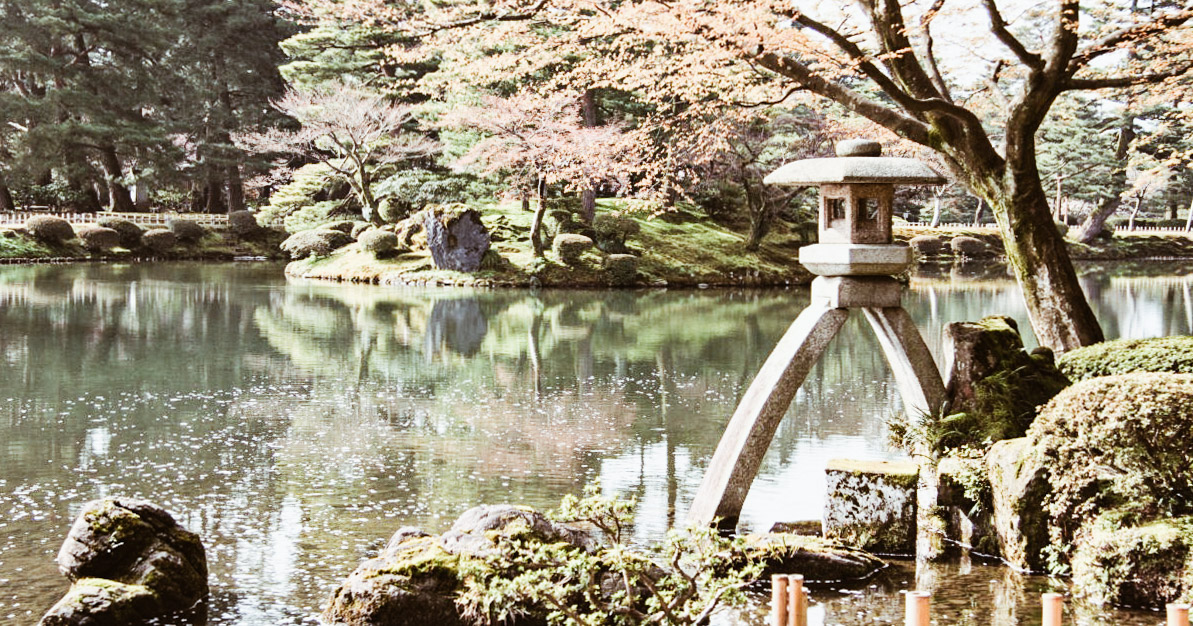
photo credits: japantravel.com
The first of our stops is Kanazawa where there is the Kenrokuen which covers an area of 11.4 hectares and is considered one of the most beautiful gardens of the Rising Sun. Kept luxuriant from generation to generation by the Maeda family since the feudal period, in Japanese the name Kenrokuen means "garden of 6 attributes" because in it are enclosed the 6 characteristics of the perfect garden: space, tranquility, artifice, antiquity, waterways and landscapes.
Official Web Site: pref.ishikawa.jp
Korakuen
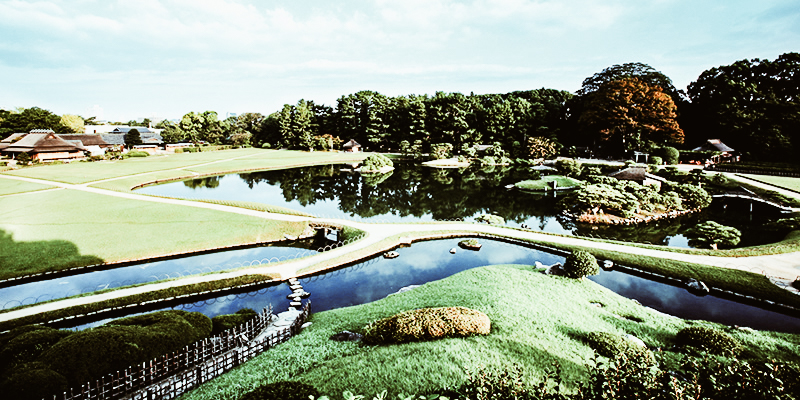
photo credits: okayama-kanko.net
The second stop takes us to Okayama, where the magnificent Korakuen stands: built in 1687 exclusively as a place of entertainment for the ruling family, it was opened to the public in 1884, when it became property of Okayama prefecture. It encloses forests, tea and rice fields, a spectacular pond and many small streams.
Official Web Site: okayama-korakuen.jp
Kairakuen
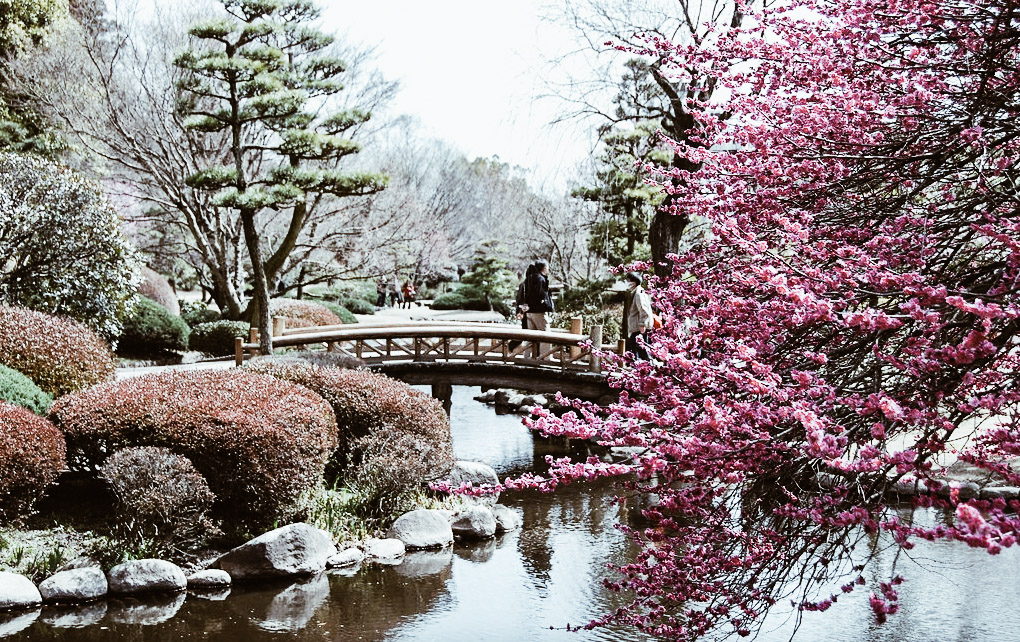
photo credits: flickr.com
We have come to the third of the most beautiful landscape gardens in Japan, we are in Mito, the capital of Ibaraki Prefecture and here Kairakuen has always been a place accessible to all, not only for the local lord Tokugawa Nariaki who had it built in 1841. This beautiful green space has become famous thanks to the Mito Ume Matsuri, the festival of plum blossoms, held between February and March: a spectacle of timeless charm.
Official Web Site: ibaraki-kairakuen.jp
Kokedera

photo credits: saihoji-kokedera.com
Our fourth visit will be to Kyoto, to the garden that is home to 120 different types of moss! It is the Kokedera or Saihoji Temple, originally part of a royal villa it became a temple almost 1000 years ago and today is considered a UNESCO World Heritage Site. Visiting this place also offers a unique opportunity, as before being allowed access, visitors must participate in kito (chanting) and shakyo (the copying of Buddhist scriptures).
Official Web Site: saihoji-kokedera.com
Shinjuku Gyoen
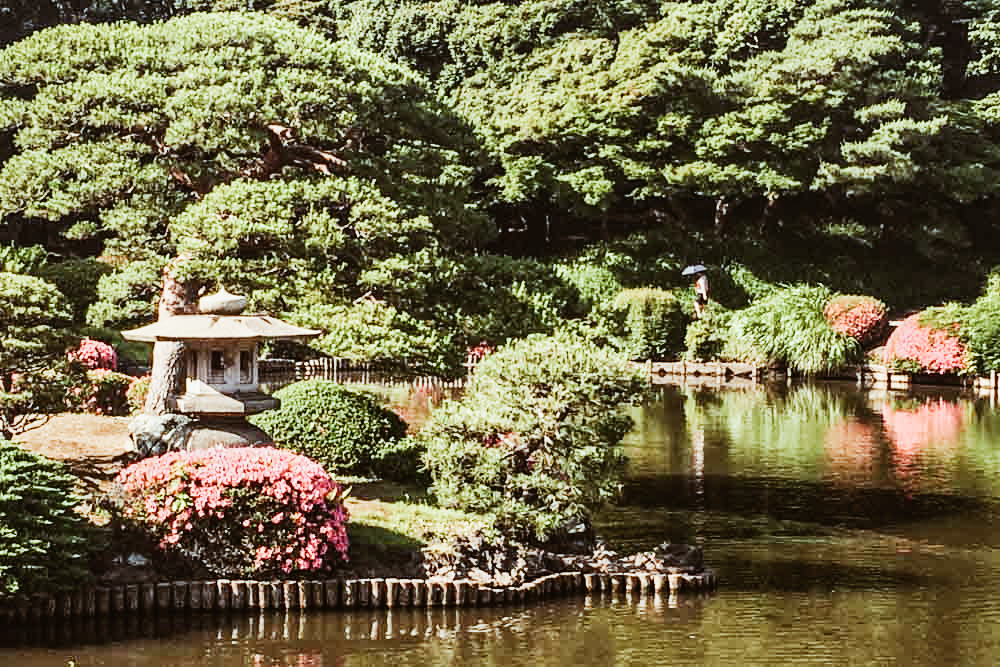
photo credits: www.japanistry.com
For our fifth stop, we fly straight into beautiful Tokyo where we can come across the Shinjuku Gyoen National Garden, one of the most striking national parks in the country. Built in the Edo period as a private residence of the feudal lord Kiyonari Naito, it became open to the public in 1949. Inside you can immerse yourself in various gardens, first of all the oldest one in Japan full of lakes, islets, bridges and pavilions. Then you can get lost in the magnificent rose garden of the French-style garden and, last but not least, enter the English-style garden with its wide green lawns lined with beautiful cherry trees: here Hanami acquires an indescribable magic!
Official Web Site: env.go.jp
Imperial Palace East Gardens
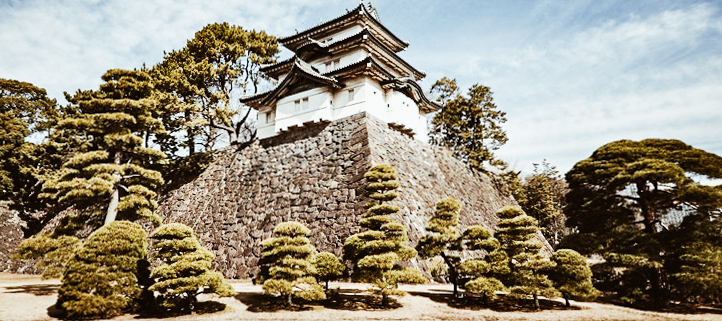
photo credits: enjoy.vivi.city
We conclude our nature trail by staying in Tokyo. Over 210,000 square meters where, once upon a time, stood the walls of Edo Castle, residence of the Tokugawa shogun who ruled Japan from 1603 to 1867. At the foot of the hill, exactly where the defensive walls once stood, lies this marvellous garden in which the Ninomaru pond is home to some rather rare aquatic plants and is covered with Nuphar Japonicum, yellow water lilies.
Official Web Site: https://www.kunaicho.go.jp
Japan, the preferred destination for people wanting to move abroad
Its timeless charm, the opportunities it offers, the hustle and bustle of its cities and the sheer size of its cities make Japan the preferred destination for all those who decide to move abroad to live and work.
Japan, the preferred destination for people wanting to move abroad
Author: Sara
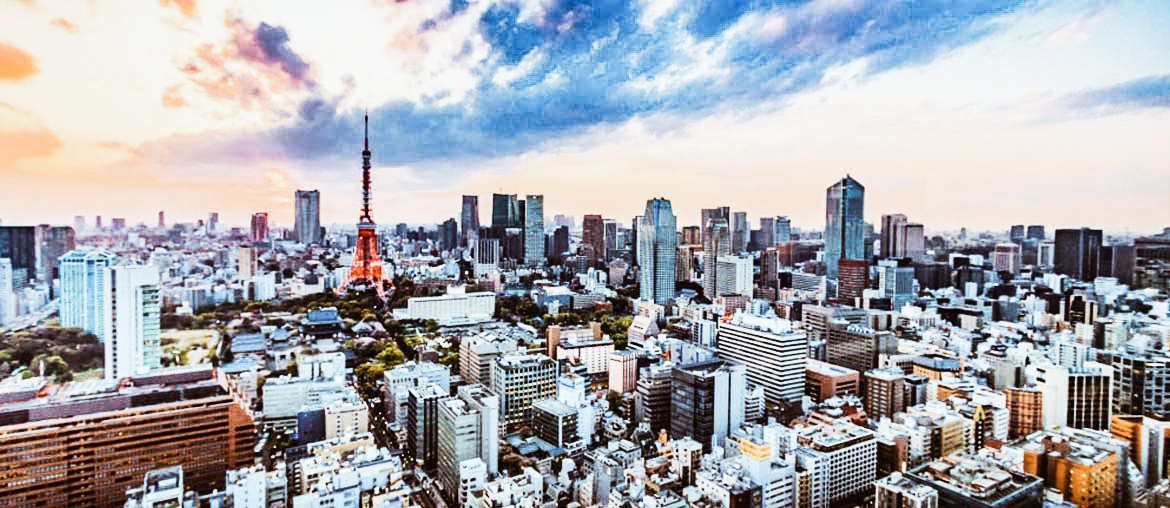
photo credits: tokeet.com
According to a global survey, Tokyo stands out among the top 5 cities in the world chosen to embark on a new life experience. Working in Japan seems to have become the aspiration of many, according to a recent ranking by Remitly, a British company that offers a global digital money transfer service to help all immigrants around the world who make great sacrifices to live and work in another country, the number of those who choose the Rising Sun as a destination to change their lives is surprisingly high, even in this time of pandemic.
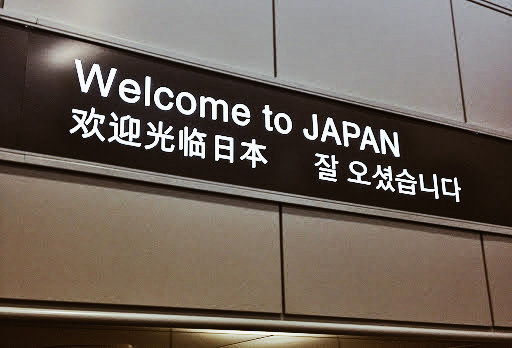
photo credits: travelwithvik.com
Online searches speak for themselves: Japan is the second most popular country in the world to which everyone wants to move after Canada! Most of the data comes from specific countries such as the USA, Australia, Thailand, Laos, Myanmar, Indonesia, Cambodia and the Philippines.
The desire to change one's life by looking to the Land of the Samurai as a destination is also increased by the high degree of safety, beauty and culture. The Japanese response to the pandemic, its rigorous conduct in establishing a state of emergency and avoiding panic and misinformation to the population, has only increased the desire to make the big move and 'try one's luck' in one of the magnificent regions of this immense island.

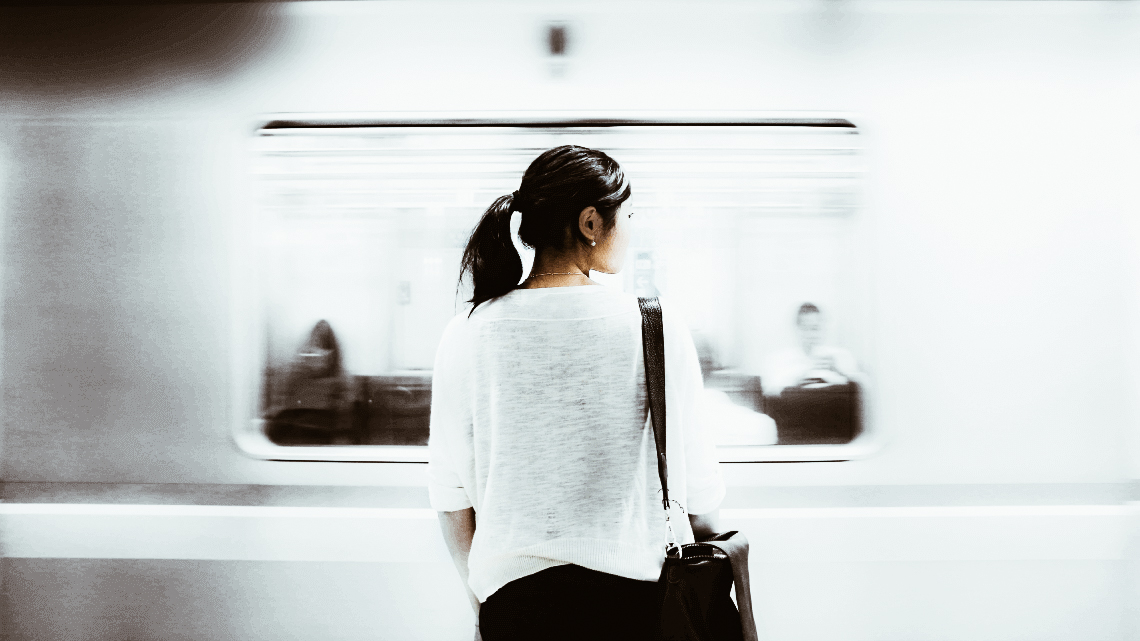
photo credits: transferwise.com, boutiquejapan.com
What do you think? Would you take the "big leap"? Is Japan the chosen destination for you too, or are there other countries you are aiming at? Let us know! And anyway, we wish you to realise all your dreams as soon as possible, 頑張ってください
Contemporary Japanese artists abroad
Japan, like Italy, is a country very attached to art and many contemporary Japanese artists have exported their works abroad.
Contemporary Japanese artists abroad
Author: Sara
Museums, art fairs and expositions have allowed the Japanese contemporary art world to look outwards. At last, even great artists are going out beyond the borders of the Rising Sun. We at Japan Italy Bridge have decided to introduce you to some of the most important contemporary artists who have received worldwide acclaim. We are talking about creatives like Yayoi Kusama, Tatsuo Miyajima, Takashi Murakami, Yoshitomo Nara and Hiroshi Sugimoto. Are you ready for this trip?
Yayoi Kusama

photo credits: wsj.com
Born in Nagano in 1929, Yayoi Kusama is perhaps the best known among Japanese contemporary artists. She began to show her immense artistic talents at the age of 10. The difficult relationship with her mother and trauma that deeply affected her led Kusama to paint her experiences on the canvas. The physical environment and her personality vanished swallowed up by the space that moved at an incredible speed. She also began to draw inspiration from Georgia O'Keeffe and wrote a letter to her. The artist replied and Kusama moved to New York where he began making monochrome paintings that immediately attracted attention.
The early 1960s were certainly not easy for a woman, especially a Japanese woman, and being able to exhibit in galleries was a difficult undertaking. However, she did succeed and became increasingly well known in the field of conceptual art. Her works include attributes of feminism, minimalism, surrealism, surrealism, art brut, pop art and abstract expressionism, all united by the polka dot technique.
Back in Japan, the artist was able to enjoy the success she deserved. Her works were exhibited at the Museum of Modern Art in New York, the Tate Modern in London and the National Museum of Modern Art in Tokyo. Between 1994 and 2012, Kusama collaborated with the musician Peter Gabriel and especially with Marc Jacobs, artistic director of Louis Vuitton. Kusama now lives in the Seiwa Psychiatric Hospital in Japan by personal choice and continues to paint daily in his studio in Shinjuku.
Tatsuo Miyajima

photo credits: smh.com.au
Born in Tokyo in 1957, Tatsuo Miyajima graduated from the oil painting course at the Fine Arts Department of Tokyo National University of Fine Arts and Music. He began experimenting with performance art before moving on to light-based installations.
Miyajima stated that the desire to create more lasting work, in contrast to the necessarily ephemeral nature of his performance and actions, motivated him to start working on sculptures and installations. Using contemporary materials such as electrical circuits, video and computers, Miyajima's highly technological work focused on the use of digital light-emitting diode (LED) counters. These numbers, flashing in continuous and repetitive cycles from 1 to 9, represent the journey from life to death, whose purpose is symbolised by the "0", a number that never appears in her work.
Miyajima has had solo exhibitions at the Ullens Center for Contemporary Art in Beijing, the Miyanomori Art Museum in Hokkaido, and the San Francisco Museum of Modern Art. She has also taken part in the Venice Biennale and numerous group exhibitions, from the Museum of Contemporary Art in Sydney to the Hiroshima City Museum of Contemporary Art. Since 2006 Miyajima has been Vice President of the Tohoku University of Art and Design.
Takashi Murakami
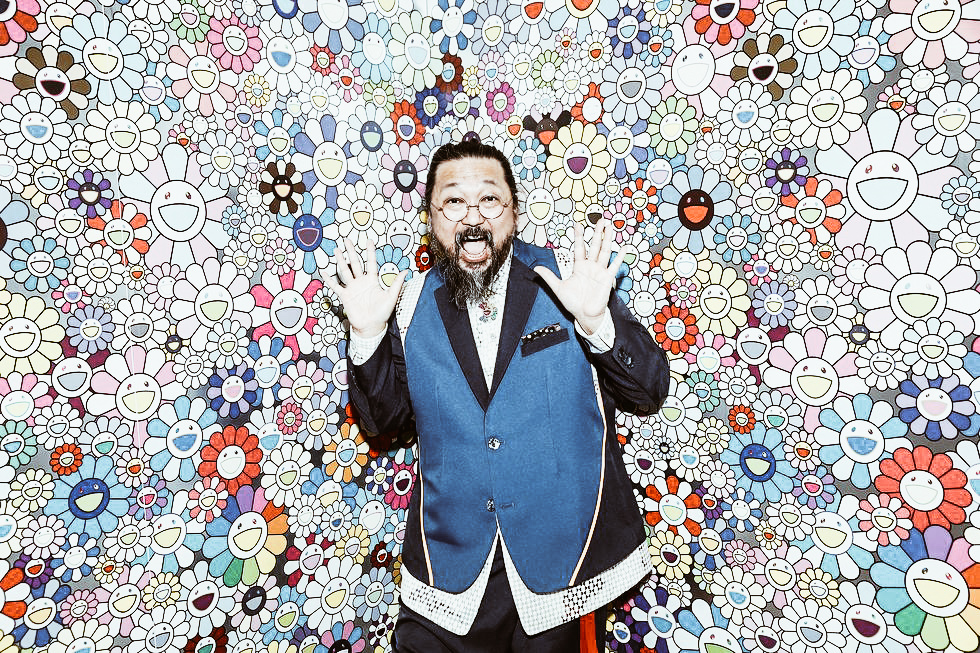
photo credits: crfashionbook.com
Born in Tokyo in 1962, Takashi Murakami began his studies of traditional Japanese painting at Tokyo Geijutsu Daigaku. However, his aspiration was to become a great mangaka. After graduating with a degree in traditional Nihon-ga painting, he won a MoMA PS1 scholarship. He moved to New York enriching his influences with the works of Andy Warhol and drawing inspiration from the production philosophies of film companies such as Disney, LucasFilm and Hayao Miyazaki's Ghibli Studio.
Among the various solo exhibitions, there is one that will mark the birth of a new Japanese art movement: "Superflat". This was the title of the exhibition at MOCA in Los Angeles which became the artist's programmatic and aesthetic manifesto systematically promoting the value of Japanese art independent of Western influences. An art capable of expressing the cultural reality of the new Japan. Superflat in fact mixes otaku elements with Kabuki and jōruri elements, fused and flattened into images with smooth surfaces and brilliant colours in which the aesthetic themes are amplified and exalted.
Murakami collaborated with Marc Jacobs and created the limited-edition Cherry Blossom bag for Louis Vuitton, designing for the occasion a kawaii pattern with the monogram of the fashion company.
Thanks to his aesthetic and entrepreneurial approach to art, Murakami has fully entered the international elite art scene, selling through third party companies, objects destined for the mass market, inventing and promoting the Kaikai Kiki and GEISAI brands.
Yoshitomo Nara

photo credits: scmp.com
Born in Hirosaki in 1959, Yoshitomo Nara studied at the Prefectural University of Fine Arts and Music in Aichi and at the Kunstakademie in Düsseldorf.
Nara is known for his paintings whose subjects are deceptively simple. We find children and animals in pastel colours with cartoon-like features with little or no background that appear both sweet and sinister. They also sometimes wield weapons such as knives and saws and their looks are accusatory. His art is a metaphor that accuses people of attacking the innocence of childhood.
Nara's objective perversions are rooted in Japanese popular culture, but these influences are mixed with those of Eastern and Western society. Her paintings, sculptures, installations and engravings explore the themes of isolation, rebellion, spirituality and religion.
Hiroshi Sugimoto
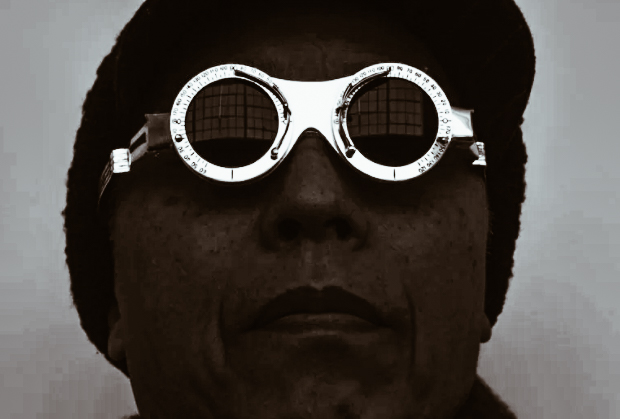
photo credits: artslife.com
Born in 1948 in Tokyo, Hiroshi Sugimoto, after obtaining his Bachelor of Arts degree, moved to Los Angeles to study photography. These studies led him, in the 1970s, to establish himself as one of the most famous contemporary photographers.
His work deals with history and temporal existence, investigating themes such as time, empiricism and metaphysics. Sugimoto has received numerous grants and his works are exhibited in the collections of the Tate Gallery, the Museum of Contemporary Art, Chicago, the Metropolitan Museum in New York and the Guggenheim in New York.
Like many contemporary artists, Sugimoto has collaborated with fashion, this time with the French company Hermès. Sugimoto's colour photos for Hermes' foulards were exhibited in June 2012 at the Museum of Cultures in Basel. During the 2014 Venice Biennale, Sugimoto unveiled his "Glass Tea House Mondiran" at Le Stanze del Vetro on the island of San Giorgio Maggiore.
The art world is full of facets given by continuous inspirations, by the search for the ego, by the need to express profound concepts without the use of words. Which of the contemporary Japanese artists have impressed you the most? Let us know in the comments!
Nada no Kenka Matsuri
From October 14th to 15th of each year, in the Matubata Hachiman Shrine (松原八幡神社) in the city of Shirahama in Himeji, Hyogo Prefecture, the Nada no Kenka Matsuri (灘のけんか祭り) one of the biggest autumn festivals in Japan is held.
Nada no Kenka Matsuri, Fighting for blessings
Author: Sara
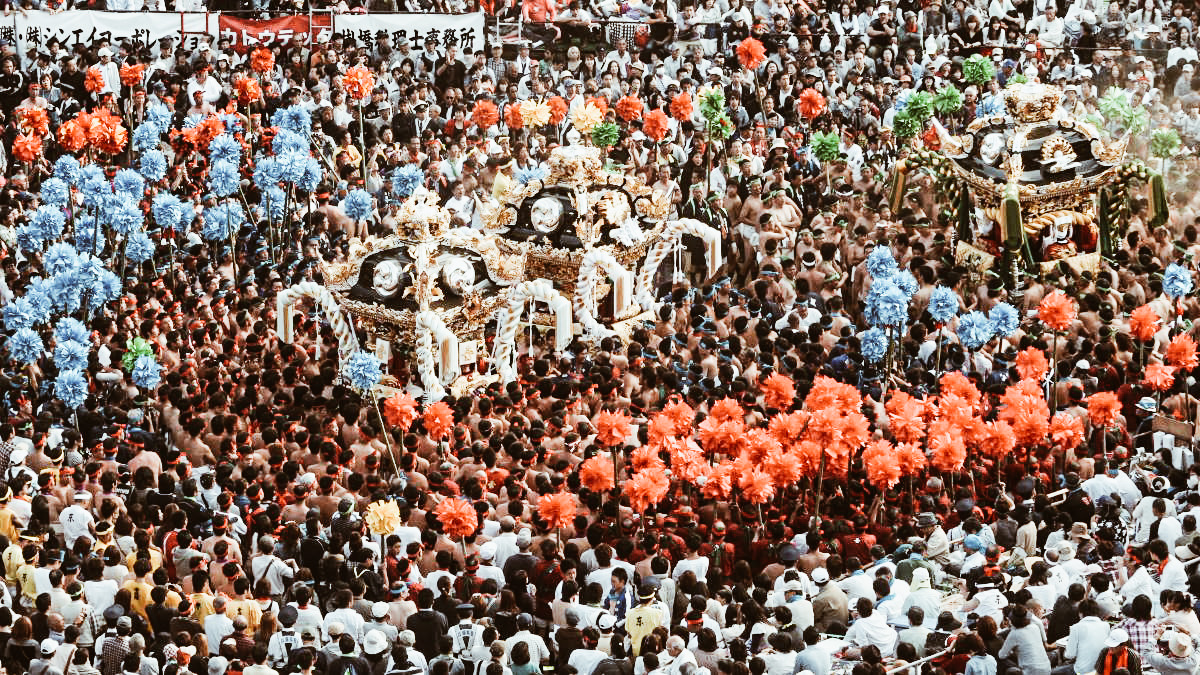
photo credits: armidaleexpress.com.au
The term "kenka"(けんか) contained in the name of the Festival means "to fight", for this reason, in the current language, it is defined as "the Festival of the fight" in which the Kami (the gods) will bless the winner of the fight with a good harvest. Given the impetuousness with which it takes place, only high school boys and men up to the age of 45 can participate in the event according to Shinto tradition. In addition, participants must belong to 7 specific villages: Higashiyama (東山), Kiba (木場), Matsubara (松原), Yaka (八家), Mega (妻鹿), Usazaki (宇佐崎), Nakamura (中村).
October 14: The Eve "Yoi-Miya" (宵宮)

photo credits: armidaleexpress.com.au
At 11:00 am everything is ready for the "Neri-dashi" parade (練りだし). The 7 Yatai (small sacred floats) from the 7 villages go to the Matubata Hachiman Shrine to receive the divine blessing, "Miya-Iri" (宮入). Here the Yatai compete in the first competition called "Neri-Awase" (練り合わせ), competing against each other. A sort of "preparation" because the real "fight" will take place the next day and will be even more difficult. At this point, the "Shishimai" takes place: a dragon dance in front of the elementary school of Shirahama.
October 15: Hon-Miya the heavy Yatai clash

photo credits: diversity-finder.net
The main event of the Festival starts at 5:00 am. The lion of the village of Matsubara (松原の獅子) celebrates the dragon dance at the Sanctuary to worship the gods. Afterwards, the ceremony moves to the ocean where the participants of the villages eliminate their impurities of the spirit by bathing in cold water (Osogi 禊). At this point, the Miya-Iri (opening ceremony) at the Matubata Hachiman Shrine is started with the blessing of the gods. At last, the thinking confrontation begins: the first are the 3 Mikoshi (the least expensive portable sanctuaries of the Yatai) of the village in charge of hosting the festival (every year the place changes alternating between the 7 villages).
The first Mikoshi (一の丸) is very heavy and is carried by men over 36 years old. The second (二の丸) is a bit lighter and is carried by men between 26 and 35 years old. The third Mikoshi (三の丸) is very light and is worn by men under 25 years old.
They fight each other twice (神輿合わせ, mikoshi-awase): first in front of the main building of the Sanctuary, then in the battlefield at the foot of Mount O-Tabi-Yama (御旅山). At the end of this clash, it is the Yatai's turn on the battlefield (Neri-awase 練り合わせ).
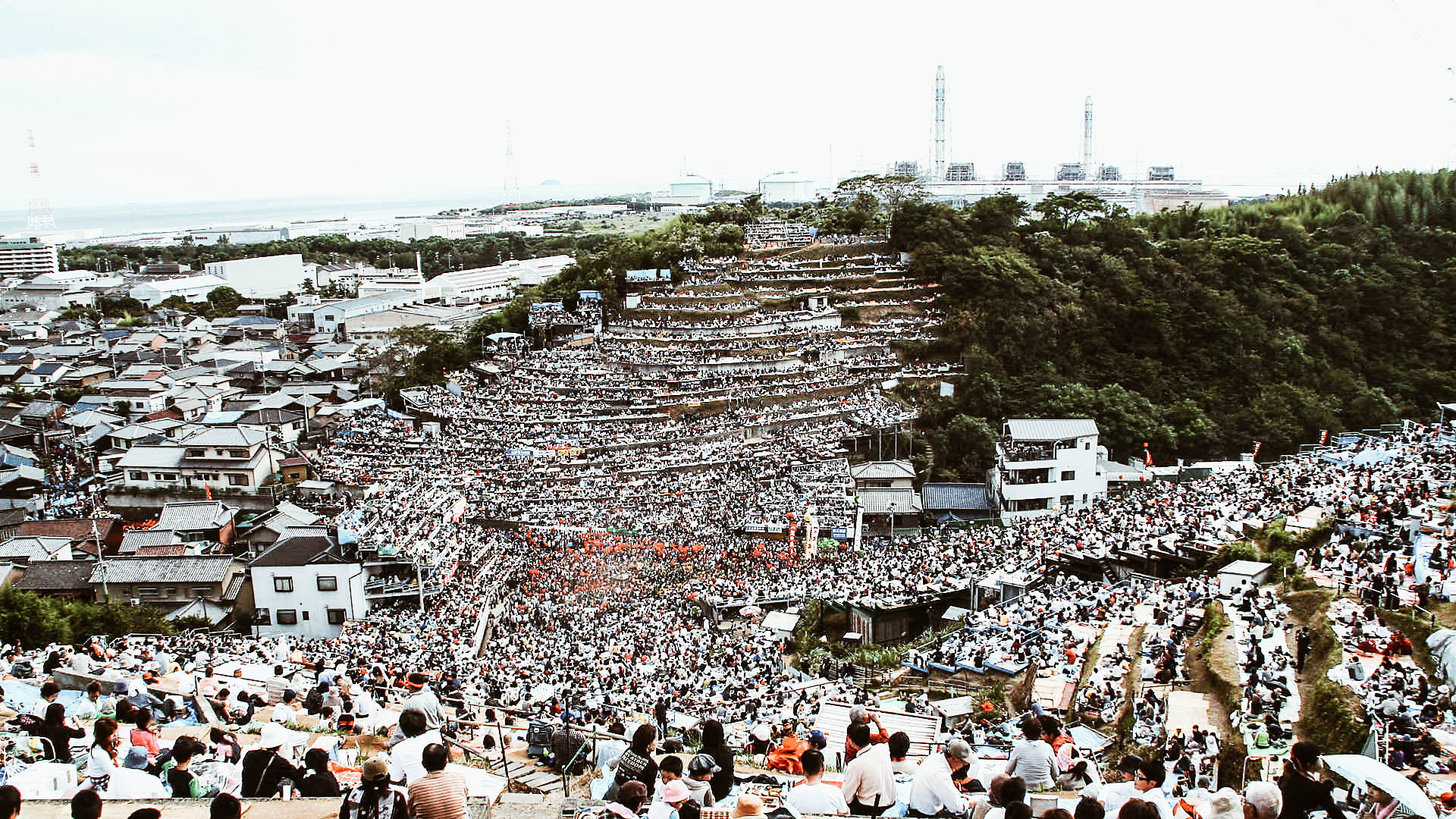
photo credits: kabegami.image.coocan.jp
The excited cries of spectators and participants make the event particularly lively and full of passion. At the end of the battle, the 3 Mikoshi and 7 Yatai are taken to the top of the mountain where prayers are said. the Nada no Kenka Matsuri ends with the descent from the mountain which will take place in the same order in which the villages have climbed.
Introduction to Japanese poetry
Italy, France, England, America and many other countries in the world offer a vast poetic production, but what is Japanese poetry like? Here we are on this fascinating literary journey to discover something more about the Land of the Rising Sun!
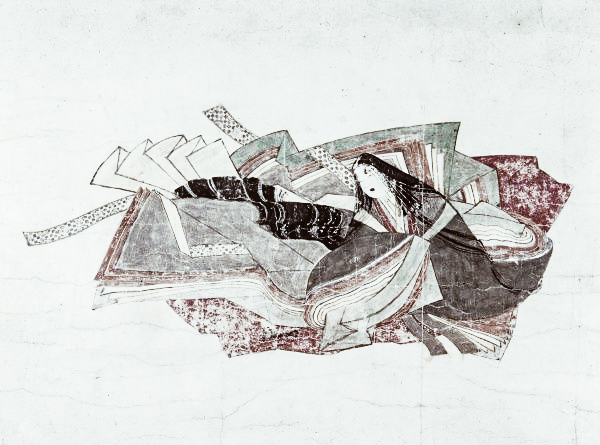
photo credits: grangerprints.printstoreonline.com
Introduction to Japanese poetry
Author: Sara | Inspiration: Tokyo Weekender
Japanese Poetry: Kanishi

photo credits: wikimedia.org
Curiously, most of the literary works of Japanese poetry were born during the Tang Dynasty, from the encounter of Japanese poets with Chinese ones. And so, under Chinese influence, Kanshi 漢詩 became the most popular form of poetry during the early Heian period among Japanese aristocrats and became increasingly popular in the modern period, especially among academics and intellectuals. The themes were free, while the forms were more rigid: the classical ones counted about 5 or 7 syllables in 4 or 8 lines, following the rules of Lushi 律詩 (rhyme on even lines with a regulated tone) and jueju 絕句 (rhyme in even lines and composed only of quatrains) based mainly on the tone of Mandarin Chinese.
The major exponents of this style are certainly Kukai, Sugawara no Michizane, Maresuke Nogi and Natsume Soseki.
Waka
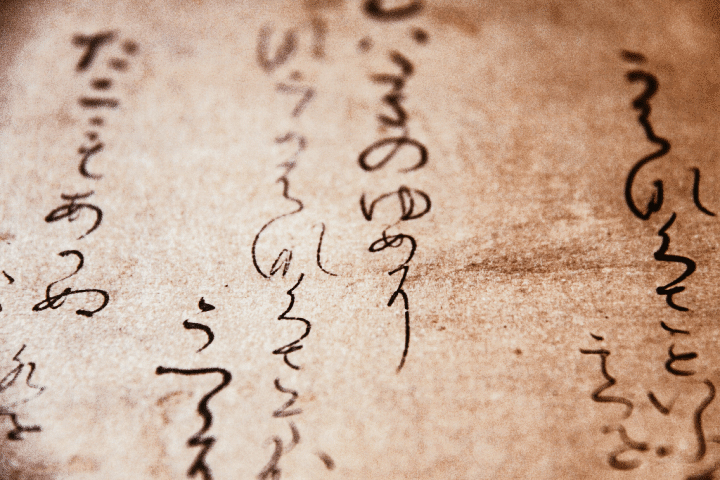
photo credits: https://matcha-jp.com/jp/289
Unlike Kanshi, Waka 和歌 was classical poetry written in Japanese with two very precise forms: Choka, 長歌, or long poems with no length restrictions. The structure is simple and consists of 2 lines of 5 or 7 syllabic sounds (which determine the accent) that ends with 3 lines of 5, 7 and again 7 syllabic sounds. Tanka, 短歌, instead has a similar structure, but they are shorter poems, often consisting of only five groups of words respectively of 5, 7, 5, 7 and, finally, 7 syllabic sounds. Waka does not follow the rhyming rules and is still very popular in modern Japan, even if now the Tanka form is preferred: the more incisive brevity reflects as always the essentiality of deep culture. The poet par excellence is certainly Machi Tawara.
Haiku
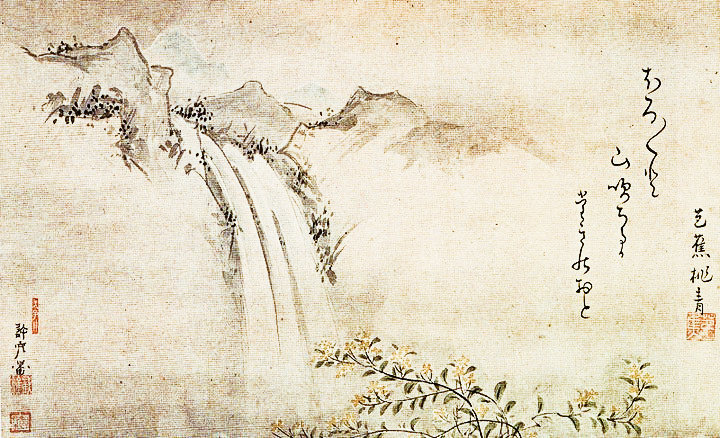
photo credits: wikimedia.org
What is the Japanese poetic composition that we consider among the most famous? Without a shadow of a doubt, it's the Haiku, 俳句. Loved by all, it is usually composed of 3 verses and 17 total syllabic sounds, schematically 5/7/5. Haiku experienced its development in the Edo period when many poets relied on this genre to describe nature and human events directly related to it. In fact, these small "compositions of the soul" express the beauty of every single instant, representing "the moment" and giving the reader that sense of "enlightenment" thanks to the images that the words evoke. The most famous and beloved poets are undoubtedly Basho, Yosa Buson, Kobayashi Issa, and Masaoka Shiki.
Our journey into Japanese poetry ends here, for now. This is a very short overview that has allowed us to enter the world of literature of our beloved Japan. What is your favourite form of poetry among the above? Mine is easy to guess: I particularly love Haiku. Here is one of my favourites by Matsuo Basho:
Let's take
the marshy path
to get to the clouds.
Continue to follow us to discover other little pearls of this oriental world and I recommend that you continue on the path you have taken: happiness is always in front of you!
Untranslatable words: Mono No Aware, Shakkei, Hikikomori, Omotenashi, Betsubara
It happened to everyone at least once to surf the internet and find articles about "untranslatable words". In fact, we often discover that every nation has special words with a certain meaning without any correspondence in its own language. Today we at Japan Italy Bridge want to try to summarize those special, unique and sometimes magical words that enclose an entire world.
Untranslatable words: Mono No Aware, Shakkei, Hikikomori, Omotenashi, Betsubara
Author: Sara
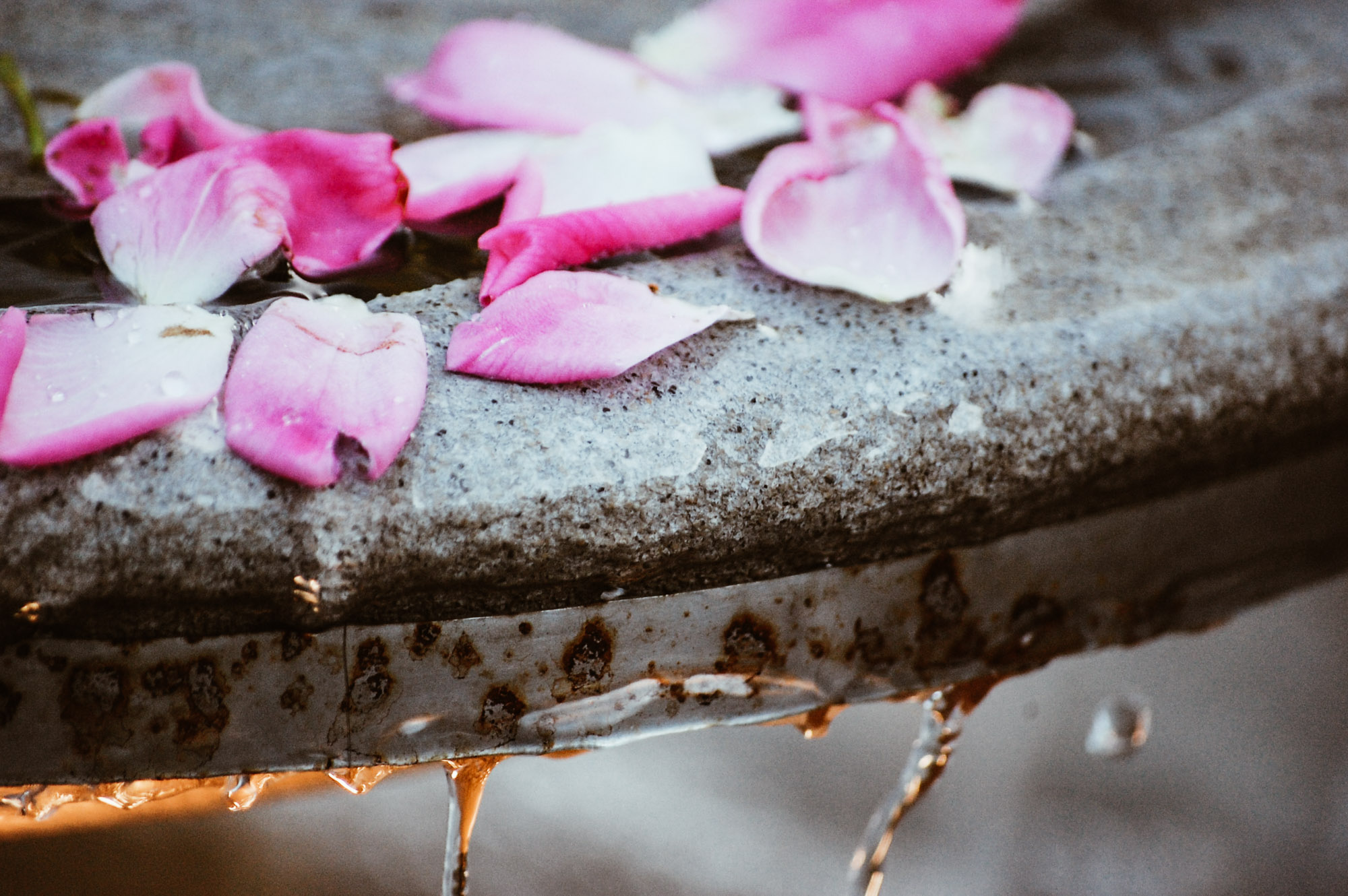
photo credits: Unsplash
Untranslatable words: Mono No Aware
The first on the list of our untranslatable words is 物の哀れ, "mono no aware". An aesthetic concept that expresses strong emotional participation in the beauty of nature and human life with a consequent nostalgic feeling linked to its incessant change. So literally we could translate it as "the pathos of things" or "the beauty of the ephemeral".
Mono no Aware finds its roots in the Heian period, but it spread only in the Edo period when the scholar Motoori Norinaga made a careful analysis and criticism of Murasaki Shikibu's "The Tale of Genji" defining it as a perfect example of "mono no aware", the perfect essence of Japanese culture. From this moment on, the creative path of many Japanese artists has had as its pivot this strange and complex concept. In fact, we find extremely sentimental the "transience" of things to take over, both in literary as well as cinematographic works. This leaves that feeling of "lack" for an ending that neither the reader nor the spectator is satisfied with. A sweet sadness and awareness that everything is destined to die slowly (and for this reason it must be loved deeply).
Shakkei
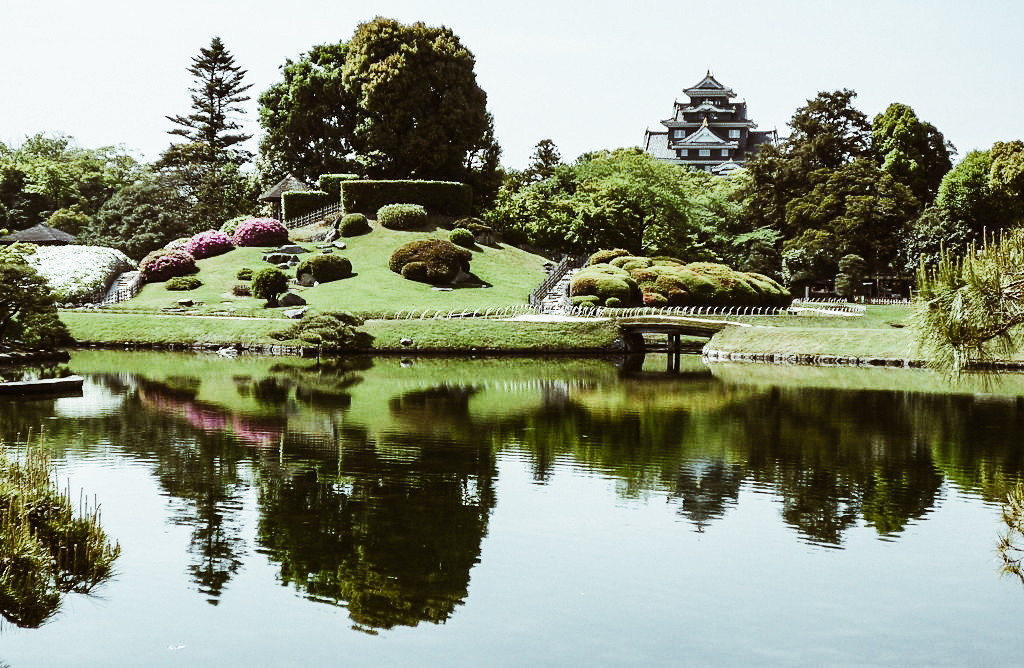
photo credits: wikipedia.org
The second expression we want to analyze is 借景, "shakkei". This time it is a particular technique literally defined as "landscape on loan", i.e. incorporating external elements of the landscape into the composition of a garden, the perfect fusion of the available elements already present with the surrounding aesthetics.
We could say that the whole of Japan refers to the concept of "Shakkei". Everything seems to be exactly in the right place in a harmonious and not shamelessly calculated and studied way. A sort of exaltation of nature as if even skyscrapers were an integral and perfect part of the whole landscape. In reality, however, this expression refers purely to the gardens of East Asia, which gives them the charm we know well. The principles of "borrowed landscape" have their roots in the Sakuteiteki (ancient Japanese gardening treatise), which developed further and further until it reached its maximum popularity during the Meiji and Taisho periods.
Hikikomori
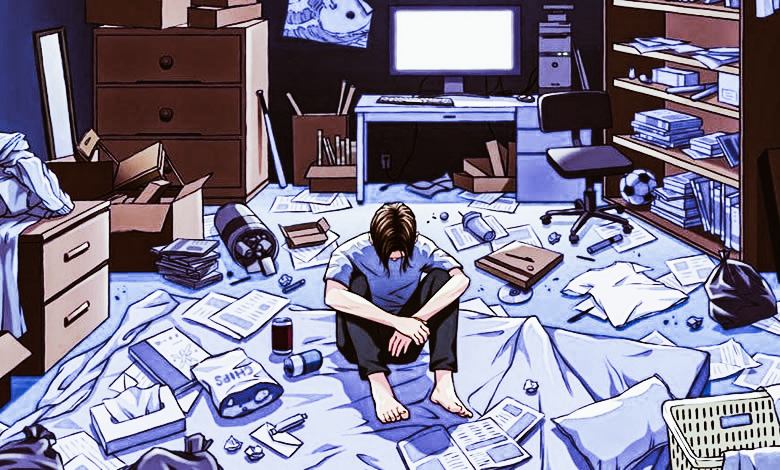
photo credits: emefka.sk
The third word is perhaps among the best known and most "dangerous". We are talking about 引き籠もり, Hikikomori. Today it is a sad social phenomenon that can have extreme consequences and goes beyond mere "isolation". There are people who decide to voluntarily withdraw from social life, seeking extreme levels of loneliness by assuming a deleterious lifestyle both physically and psychologically. Night and day are reversed, direct relationships are often replaced by virtual ones or, in even more extreme cases, none at all. The hikikomori wanders around his room, devoid of any stimuli and this, as is intuitable, are characteristics that distinguish depressed subjects with obsessive-compulsive attitudes.
The first to give a name to this particular phenomenon was the psychiatrist Tamaki Saitō when he observed that the number of those who presented this deep lethargy towards life increased and the characteristics were always the same. Therefore, we can define Hikikomori as a syndrome rather than a word in itself.
Untranslatable words: Omotenashi

photo credits: livingnomads.com
The fourth on the list is お持て成し, "omotenashi". It is really difficult to find an equivalent that can even give an idea of this wonderful concept. We could use the word "hospitality", but it is almost reductive. This word expresses one of the most complex and profound aspects of Japanese culture. Omotenashi is the will to be attentive and take care of others. It also means to give importance to details, to be aware of one's own actions, to have the sensibility to seek harmony and to make others feel good. It was the Buddhist monk Sen no Rikyū who established the principles and good rules of conduct during the famous tea ceremony, an expression of the utmost care towards the guest.
There fore, Omotenashi is a reflection of Japan, the basis on which the behavioural etiquette of the entire country is rooted. Even if it is not said that this sense of "hospitality" is always encountered (the whole world is a country: there are also very unfriendly Japanese!), but you can easily perceive it when you experience it.
Betsubara

photo credits: lickthatspoon.blogspot.com
The last term we will address today is べつばら, "betsubara". It's a word that can make you smile and literally means "separate stomach." This is where all dessert goes when you say you can't eat another bite, but you eat it anyway. It's a bit like when you say, "there's always room for dessert" even though you already feel totally full. Obviously it can be understood for any food you have a weakness for: it can be ramen, sushi, pizza. So everyone has a different "betsubara"! Which one is yours?







